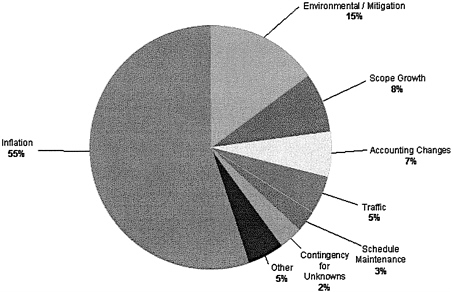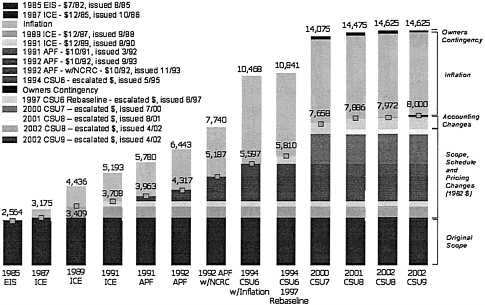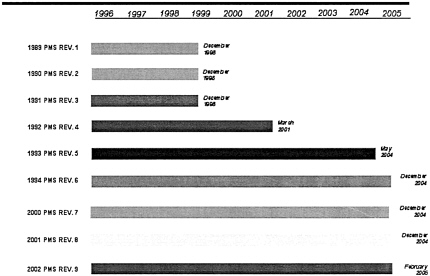2
Cost and Schedule Procedures
INTRODUCTION
The focus of this report is the procedures that are currently in place (October 2002) to control costs and schedules of the project through its projected completion in 2005. However, when trying to envision a project’s future it is important to be aware of its past, and the past performance of the CA/T project has been notorious for cost growth and schedule delay.
BACKGROUND
Since the project’s Final EIS approval by FHWA in 1985, costs (in constant dollars) have grown to more than three times the original estimate (Figure 2.2) and the duration has increased by 6 years (Figure 2.3). Analysis of the project’s performance presented to the committee by the CA/T project management team indicated that about half of the cost growth was caused by inflation1 (the original estimates were in 1982 dollars, as required by FHWA) and that a portion of this could be attributed to the extended schedule. The analysis also indicated that 3 percent of the increased cost resulted from efforts to maintain the schedule and about 28 percent derived from increased scope and unplanned expenses to mitigate the project’s effect on the environment and the movement of traffic in Boston (Figure 2.1). The project-management team asserted that the increases would have been greater if they had not initiated procedures to control the growth of costs and schedule. For example, the project team claims to have saved $750 million through approved cost-containment initiatives, as well as $500 million saved by deploying its Owner Controlled Insurance Program (OCIP).
The cost and schedule performance problems may be attributed to many different sources, including the low original estimate, inflation, cost of mitigation, unexpected technical complexities, delays in making decisions, and changes during construction. A recent review of large public works projects over the last century concluded that they are consistently underestimated, a phenomenon attributed to the desire of the project advocates to have their projects approved (Flyvbjerg, 2002). Others have reached similar conclusions (Wachs, 1989; Merrow, 1988), as did a writer in the local press, who characterized the project’s original cost estimate as follows:
[The Big Dig sponsors’] early estimates were deliberately optimistic. Politically, they had no choice. If they’d been honest, the project never would have happened, because Americans are unwilling to face the actual cost of great civic projects (Campbell, 2000).
The original estimate was developed in 1982 dollars, without allowance for inflation or mitigation, and was presented in the 1985 Environmental Impact Statement (EIS) before detailed technical studies had been undertaken. The 1982 estimate was based on guidelines in FHWA’s Interstate Cost Estimate (ICE) manual, which excluded inflation. It was thought that inflation would be captured during biennial updates. Inflation has indeed had a significant impact on the project cost, but the impact is difficult to assess accurately because of the dynamic interplay of the project’s scope, schedule, and construction costs.

FIGURE 2.1 Cost History and Scope Evolution (Source: W.Edwards, “Project History,” Presentation to the Committee on October 21, 2002)
Downtown Boston is the location of many of America’s most important educational, cultural, and financial institutions, and the project extends into several residential neighborhoods as well. Mitigation costs, therefore, could be expected to be very high. Requirements for significant mitigation were identified in the original 1985 EIS, but the costs were not identified.
The project team described mitigation resolution as a consensus-building process involving negotiations with neighborhood, business, development, and environmental groups to ameliorate negative impacts of the construction. This occurs, for instance, by introducing major design changes, routing the construction around residential areas, and constructing bypass roads, all at considerable cost. There is by no means any universal agreement, however, that the money is always spent well or in the service of stated goals. The Honorable Tom Petri (R-Wisc.), chairman of the House Transportation and Infrastructure Committee, has called CA/T expenses that had little or nothing to do with construction a “golden opportunity” for spending federal highway funds on local government agencies, businesses, and educational institutions (Petri, 1997).
Even without the advantage of hindsight, the risks of highly technical engineering design and construction, unknown soil conditions, existing underground utilities, and other factors that increase costs and delay schedules should and could have been anticipated and addressed through additional planning and design, site analysis, and cost and schedule contingencies. As it happened, the impact of unanticipated physical factors was often compounded by delays in making timely project decisions. This was the case, for example, in the delayed decision making on the Charles River crossing, which caused years of delay on this part of the project.
COST AND SCHEDULE CONTROL
Value Engineering
Two types of value-engineering programs—management-initiated and contractor-initiated—have been employed on the CA/T project. The project-management team presented an example of how a management-initiated design change ofhternal tunnel finishes was used to control costs. Reducing the height of the tiled surfaces, using stainless steel panels, and eliminating tiled trim at the junction of the wall and ceiling saved an estimated $70 million. However, the stainless steel panels have apparently interfered with the wireless communications system, creating unanticipated problems not yet resolved at the time of this writing. In any case, the IPO indicated that the $70 million saved on this change was only a part of $480 million saved overall through management-initiated value engineering.
Another example presented by the integrated project organization (IPO) was the Fort Point Channel crossing, which was said to benefit from significant engineering and management effort to control cost and schedule. However, the committee questions whether there was sufficient effort to explore the alternative approach, a bridge crossing, which would have been much less expensive.
The committee was informed that all construction contracts had a provision, called the value engineering change proposal (VECP) program, for contractor-initiated value engineering. The project team claimed savings of $25 million from this program thus far, though the committee believes this is negligible when compared to the $9 billion value of construction.
However, the total savings from both VE programs is approximately $505 million, according to the project staff. This value is approximately 5.8 percent of the total construction commitments to date, which is slightly above the average for VE savings on federal aid highway programs (FHWA, 2002).
As noted earlier, the design of the project is virtually 100 percent complete and the construction is 85 percent complete, thereby limiting opportunities for additional cost and schedule savings from value engineering changes. Nevertheless, the committee believes that the VECP program should be pursued.
Fast-Track Construction
The project used a fast track design and construction delivery method to reduce the overall project time. Typically, fast-track delivery involves dividing the project into sequential work packages and starting construction on the earlier segments before completing design of the latter segments. This process works best when the design of each work package is complete and the impact of requirements of the later segments can be anticipated. The CA/T work packages had complete civil design, but they frequently required modifications to accommodate project-wide systems that were designed in later packages. The result has been a high rate of claims and changes, which is discussed in Chapter 3.
An analysis by the project-management team claims that the project has realized a 3:1 cost-benefit ratio by utilizing fast-track methods (i.e., the accelerated schedule saved $3 for each $1 of additional costs attributed to using fast track). However, the committee does not believe that the full cost impact of changes, claims, and delays from incomplete coordination of work packages has been considered. It should be noted that different people interviewed by the committee defined “fast track” differently, which further complicates the attribution of benefits.
Managing Cost and Schedule
Attempts to mitigate cost increases and schedule delays have been made through application of project-management tools. The project management consultant Bechtel/P arsons Brinckerhoff (B/PB) developed a dynamic Milestone Manager process to provide real-time project performance data; B/PB used it to forecast project delays and develop new work sequences to work around the delays. For example, when I-90 was 19 months behind schedule, the consultant was able to recover 8 months of delay by accelerating other key parts of the project.
CURRENT STATUS
With the project so close to being complete, the risks of future scope increase, mitigation requirements, and technical problems should be reduced and there should be a high level of certainty on the remaining cost and time. The budget includes substantial cost, schedule, and administrative contingencies, and the staff has almost 20 years of project experience all of which contribute to minimal decision risk. Nevertheless, the project continues to experience delays and costs increases, most recently exemplified by the delayed opening of the Interstate 90 connection
to Logan Airport from September 7, 2002, to November 8, 2002, then to December 20, 2002; the connection finally opened over the weekend of January 18, 2003.
The potential cost of that delay was covered by the budget contingency, but the committee believes that delays in such critical milestones at this stage of the project are unacceptable and can severely undermine the credibility of the MTA. Therefore there is a need to identify and assess the current cost and scheduling risks and to develop strategies to manage them through completion of the project.
The IPO reported to the committee that the continued delays in opening the I-90 extension were primarily caused by one contract that involved the installation of traffic monitors and controls in the tunnel. The IPO also reported that it was accelerating work on all contracts to meet the scheduled completion date, but that the date was still continuing to slip. The committee concludes that the persistent scheduling problems result from failures in coordination together with insufficient emphasis on accelerating work that would be most critical to maintaining the schedule.
The Washington State Department of Transportation (WSDOT) has developed a Cost Estimating Validation Process (CEVP) that resembles value engineering. In this procedure, an independent team of experts is brought together in a workshop setting to review the project’s estimated cost and schedule, as well as its risk-management strategies. The team not only identifies actions that will improve performance but also helps communicate to the public the assumptions and potential cost impacts of identified risks (WSDOT, 2002). The CA/T could have benefited from a CEVP-type process when it began in 1982, and although options are now limited such a process could still help the IPO to control cost and schedule for completing the project (see also the discussion of peer reviews in chapter 5).
FINDINGS AND RECOMMENDATIONS
Schedule Management
Finding 1: Meeting the CA/T project’s scheduled targets continues to be a problem. Despite an emphasis on reaching the milestones on time, slippage continues, thereby reducing public confidence in CA/T management.
This problem was particularly evident during the continual postponement of the opening dates of I-90 and I-93N, which occurred while the committee was doing its work. The slippages seem to stem from managers focusing more on the short-term details of the project activities and less on evaluating the project risk as a whole in advance of potential occurrence.
Recommendation 1: CA/T project managers should strategically evaluate future schedules by determining what critical tasks need to be done without fail and how long these activities will likely take. Published completion dates should be developed around realistic workflows and schedule risks, with modest allowances for unknown issues.
These evaluations should allow the project director to make reasonable projections for completion of the project. The work could then be pushed to deliver even earlier, thereby possibly beating the published date.
Cost Management
Finding 2: The project has had large cost increases resulting from changes in scope, design, and project limits, as well as from deficiencies in coordinating contracts.
Recommendation 2: All contract modifications should be comprehensively reviewed— prior to execution—for impacts on scope, design details, interfaces, and contract duration.
Reliable cost and schedule estimates should be based on consideration of alternatives, full development of scope, knowledge of existing conditions, sequence of activities, and the coordination work between packages.
Cost/Schedule Tradeoff
Finding 3: The committee could not identify sufficient analysis to justify all construction-acceleration efforts that have occurred.
There is a concern that the premium costs for construction acceleration (extended periods of overtime and longer workweeks, for example) could lead to problems with work quality and a bigger-than-expected list of items to be reworked or completed prior to acceptance.
Recommendation 3: The MTA should rigorously analyze all costs associated with project acceleration, especially for completing the key critical path tasks (those in which a delay could cause critical project milestones to be missed).
Value Engineering
Finding 4: The savings from contractor-proposed “value engineering change proposals” (VECPs) to date is $25 million, which is a negligible amount compared with the constructed value of the project.
Recommendation 4: The MTA should aggressively promote the VECP program for the remaining work. This effort should increase contractors’ level of awareness, encourage innovation, and yield cost reductions.
REFERENCES
Flyvbjerg, B., M.S.Holm, S.Buhl. 2002. “Underestimating Costs in Public Works Projects: Error or Lie?” Journal of the American Planning Association. 68(3): 279–295.
Campbell, Robert. 2000. “Forget overruns; Big Dig’s a marvel.” Boston Globe. 25 August, pp. C1 and C8.
Wachs, Martin. 1989. “When Planners Lie with Numbers.” Journal of the American Planning Association. 55 (4): 476–79.
Merrow, Edward W. 1988. Understanding the Outcomes of Megaprojects. The Rand Corporation.
Petri, Tom. 1997. “Big Dig Wins Second Porker.” Available online at http://www.house.gov/petri/porker/sepl9prk.htm. [January 20, 2003].
Federal Highway Administration (FHWA). 2002. “Summary of Past VE Savings—Federal Aid Highway Program.” Available online at http://www.fhwa.dot.gov/ve/ [January 22, 2003].
Washington State Department of Transportation (WSDOT). 2002. “Cost Estimating Validation Procedure.” Available online at http://www.wsdot.wa.gov/projects/cevp/default.htm [December 30, 2002].










